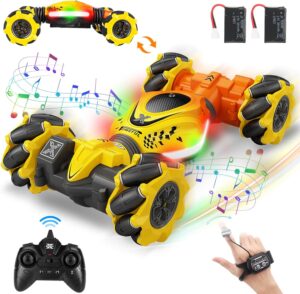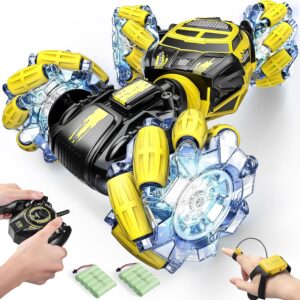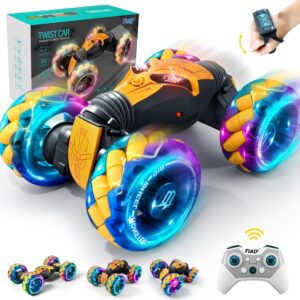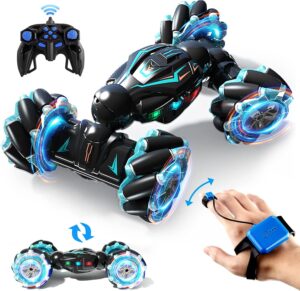From backflips to corkscrews, RC stunt cars let drivers defy gravity and pull off moves that seem to belong in an action movie. These radio-controlled vehicles may look like regular RC cars on the outside, but inside they are purpose-built machines optimized for extreme stunt driving.
RC stunt cars are engineered to take the abuse of huge air, big crashes, and other maneuvers that would destroy hobby-grade RC cars. With the right modifications and reinforcements, RC drivers can push the limits of what’s possible and develop truly jaw-dropping stunt skills.
In this guide, we’ll dive into the world of RC stunt cars to understand what sets them apart. We’ll look at how their customized components and geometry allow death-defying feats without destroying the car. From the chassis and suspension to the power system, tires and electronics, we’ll explore what makes these machines prime for stunting.
We’ll also provide tips on choosing the right stunt RC car, whether you’re a beginning driver looking to get airborne or an experienced hobbyist pushing the boundaries. With the right car and practice, anyone can unlock their inner stunt driver. So let’s get ready to go big and defy gravity with the amazing capabilities of today’s RC stunt cars!
What is an RC stunt car?
An RC stunt car, also known as a stunt remote control car, is a radio-controlled (RC) model car that has been designed and built specifically to perform stunts. Unlike regular RC cars used for racing or recreation, stunt RC cars are engineered to be extremely durable and to handle the impacts and stresses of jumping, flipping, rolling, and crashing during stunts.
The chassis and body of a stunt RC car is made from strong, lightweight materials like carbon fiber or hard plastics to withstand crashes. The suspension is reinforced and designed to be very rigid yet still absorbing impacts. Stunt RC cars will often have four wheel drive or rear wheel drive with good torque to maintain control. The tires have lots of tread for grip, and are large and inflated to absorb landings.
Another key component is the transmission and motor system. Stunt RC cars need a high level of throttle control as well as quick acceleration to execute maneuvers. They are equipped with more powerful motors and speed controllers compared to a basic RC car. Some may even use gas engines for more power. The drivetrain is rugged and designed to handle extreme forces without breaking.
Stunt RC cars allow drivers to execute amazing tricks like broad jumps, flips, rolls, and high speed turns. With the right modifications and reinforcements, these cars can take abuse during stunts that would wreck most other RC vehicles. Their specialized design and engineering is what enables RC drivers to successfully perform death-defying feats and pushes the boundaries of what’s possible with radio-controlled models.
How do RC stunt cars work?
RC stunt cars are controlled remotely using a handheld transmitter. This sends radio signals to a receiver inside the car, which relays the signals to an electronic speed controller. The speed controller then regulates power from the battery pack to the motor, controlling the torque and RPMs.
The motor powers the drivetrain and wheels, propelling the stunt car forward or in reverse. More advanced speed controllers allow proportional control of the throttle and braking for precise maneuvers. The transmitter has buttons to steer the car by electronically adjusting the servo connected to the front wheels or vehicle’s rudder.
Higher quality transmitters using 2.4GHz spread spectrum technology provides more responsive, lag-free control for stunt driving. The controller’s range can reach up to several hundred feet depending on conditions, giving ample space for operating the car.
For stunts like jumps and flips, RC drivers will make adjustments to the car’s center of gravity and weight distribution. This helps optimize takeoff and rotation in the air. The car’s suspension can also be tuned to the stunt – stiffer springs and shocks for big air, softer settings for better grip during stunt driving.
ESC programming allows tweaking parameters like throttle and brake sensitivity to suit the driver’s style. Traction control, throttle punch, and other settings can be customized for stunts. The gearing in the transmission can be set for faster acceleration or higher top speeds depending on the stunt. A stunt RC car is a highly-engineered platform that drivers can configure for optimized stunting performance.
What features make a good RC stunt car?
Durability – A stunt RC car must be extremely durable, with the ability to withstand crashes, jumps, rolls, and tumbles. The chassis should be rigid and absorb impacts without bending or breaking. Materials like carbon fiber, aluminum, or durable plastics are ideal. Suspension parts like shocks, arms, and camber links should also be rugged.
Power – A good power-to-weight ratio is crucial for stunts. A powerful motor provides quick acceleration and torque for jumps, while lightweight body materials keep the car agile. Brushless motors offer more efficiency and higher RPMs than brushed motors. 2S or 3S LiPo batteries can supply the needed amperage and voltage.
Control – Precise throttle and steering control are essential for executing maneuvers. A high-quality radio system with a sensitive receiver and smooth, proportional controls enables finessed inputs. 4WD or RWD drivetrains offer responsive steering and traction for stunts.
Tires – Large, soft rubber tires with deep treads provide plenty of grip for acceleration, landing jumps, and changing direction quickly during stunts. Belted monster truck tires absorb impacts well while resisting punctures and ballooning.
Geometry – Having an optimized wheelbase, ride height, suspension geometry, and weight balance improves how the car handles in the air and when landing. This geometry can be tuned with parts like adjustable control and camber links.
Upgrades – Upgrading motor, tires, shocks, and components to more robust aftermarket parts greatly improves stunt performance. Reinforcing parts with metal upgrades like turnbuckles, hubs, and chassis brace also adds durability.
With the right combination of these features, an RC car can handle the demands and abuse of extreme stunt driving. Careful setup and tuning brings out its full potential as a stunt machine.
What types of stunts can you do with an RC stunt car?
Jumps – One of the most common RC stunts is big air jumps. By hitting ramps, cliffs, or any type of launch at speed, stunt cars can get huge hang time and air. Skilled drivers can execute tricks during the jump like flips and spins. Tuned suspension and landing gear allows huge jumps with smooth landings.
Rolls – Stunt drivers use ramps, embankments, and dips to make their RC cars roll side over side. Barrel rolls, end over end rolls, and corkscrew rolls are possible. Reinforced chassis, cages, and bumpers allow repeated roll stunts.
Backflips – By launching off a kicker ramp at full throttle, the momentum carries the car into a reverse backflip, landing on its wheels. Adjusting ramp angle, launch and takeoff speed is key for clean rotational flips.
Corkscrews – This stunt combines a rolling and flipping motion. The car is sent into a roll while also rotating axially, creating a spiral corkscrew effect. Tuned suspension geometry allows corkscrews to happen in mid-air.
Drifting – RC stunt drivers practice high-speed drifting and power slides to show car control. Adjustable differentials, stiff rear suspension, and throttle modulation allow sustained, controlled drifts.
Burnouts – Spinning the rear wheels at high speed produces dramatic tire smoke. It involves careful throttle control to maintain wheel spin without losing traction.
Crawls – Driving or climbing over extreme terrain or obstacles can be considered stunt driving. With 4WD, high ground clearance and the right tires, RCs can crawl over almost anything.
The limits of RC stunts keep getting pushed further through car innovation and driver creativity. The possibilities are endless for those skilled in stunt RC driving.
What are the best RC stunt cars?
When it comes to radio controlled stunt driving, having the right car is crucial for pulling off thrilling jumps, flips, and tricks. But with so many options on the market, how do you determine the best RC stunt cars to go big? We dive into the top stunt vehicles across multiple scales and classes that allow hobbyists to get maximum air and master insane maneuvers. Whether you’re looking to conquer tall ramps or compete in freestyle contests, read on for our picks for the best RC stunt cars available today.
Fosgoit Gesture Sensing RC Stunt Car
The Fosgoit Gesture Sensing RC Stunt Car brings innovative gesture control to the world of radio controlled stunt vehicles. Using integrated motion sensors, this 1/18 scale four-wheel drive stunt car can perform spins, drifts, and tricks based on your hand motions. Simply move your hand to drive the car forward, backward, rotate left or right, and more up to a range of 45 feet.
Power comes from a set of brushed DC motors giving the 3.5oz car enough speed and torque for small jumps and driving on multiple surfaces. The 7.4V 850mAh Li-ion battery provides up to 30 minutes of drive time. Bright LED lights and cheerful music add to the excitement as you control the car via gestures.
For more precision control, the included 2.4GHz controller allows traditional operation up to 130 feet away. Rubber tires with deep treads grip the ground during fast maneuvers while the four-link suspension handles small impacts well. At just under 7 inches long, the Fosgoit Gesture RC car is sized right for indoor and outdoor stunt driving.
DoDoeleph Gesture RC Stunt Car
The DoDoeleph Gesture RC Car brings versatile driving modes to a 1/16 scale radio controlled vehicle. This stunt truck can toggle between an arched, off-road mode and a flat on-road mode using its flexible spine design. Mecanum wheels allow omnidirectional movement go forward, reverse, sideways, and spin 360 degrees. Gesture sensors inside the 2.4GHz watch controller detect hand motions to drive the car.
Under the hood, a set of 7500 rpm motors powered by 7.4V 500mAh batteries provide speed up to 12.5 mph and about 50 minutes of runtime. LED lights on the front and rear add excitement, especially in low light conditions. Weighing 1.1 lbs, the lightweight ABS plastic body withstands minor crashes and is easy to flip back over if overturned.
The 2.4GHz radio system offers up to 165 feet of driving range, stable control for multiple cars, and option of traditional remote operation. This versatile and innovative RC car brings multi-terrain driving and gesture controls together for kids and adults.
FUUY Gesture Sensing RC Stunt Car
Bringing tricked out stunt performance and multifunction controls, the FUUY 1:12 Gesture Sensing RC delivers versatile operation for drivers. This 1.4lb four-wheel drive vehicle can be controlled via traditional 2.4GHz remote up to 300 feet away or innovative gesture sensing watch. Mecanum wheels enable omnidirectional driving like drifting, spinning, and crossing obstacles.
Built on a flexible spine chassis, the car shifts between speed mode for asphalt and off-road mode for rougher terrain. Powered by a 7.4V 1500mAh battery, speeds reach up to 12 mph driven by silent electric motors. Colorful LEDs illuminate the exterior for nighttime stunts. Durable ABS plastic construction withstands bumps and crashes from stunts.
This RC brings advanced tech like gesture controls together with proven stunt car capabilities. The 1:12 scale places it in a sweet spot between smaller toy-grade RCs and large-scale hobby racers. Drivers can perfect drifting, crossovers, and other maneuvers with the FUUY’s great control and versatile performance.
Deejoy RC Stunt Car
Bringing versatility to stunt driving, the Deejoy RC Stunt Car combines multifunction controls with durable stunt-ready construction. This 1:12 scale remote control vehicle can be driven traditionally with the included 2.4GHz controller or via gesture sensing watch. Mecanum wheels enable omnidirectional movement like drifting, spinning, and maneuvering obstacles.
The four-wheel drive system powers the 3.5 pound car to reach speeds up to 12 mph, enough for small jumps and tricks. Bright LEDs lights and cheerful music add to the excitement while driving. A 1300mAh rechargeable Li-ion battery provides up to 60 minutes of fun. The reinforced plastic body withstands minor crashes and is designed to flip back over after rollovers.
For new and experienced RC drivers alike, the Deejoy RC Stunt Car brings versatile controls together with proven stunt car durability. Drivers can master drifting, donuts, and crossover techniques using either the traditional or innovative motion-based controls. With both options powered by advanced 2.4GHz technology, the car responds reliably for total driving freedom.
How do you choose the right RC car for stunts?
Consider the size – 1/10 scale and 1/8 scale cars are common for stunts. Larger 1/8 models handle jumps better with more stable landings. Smaller 1/10 cars are more agile but durability can be a concern.
Prioritize durability – Look for rugged parts like aluminum chassis, hinge pins, turnbuckles and heavy duty shocks. Multiple suspension arms absorb impacts better than single arms. Strong drivetrain parts handle the extreme forces of stunts.
Evaluate the power system – Brushless motors offer more speed and acceleration than brushed. 2-3S LiPo batteries have high discharge rates for power. Waterproof electronics are a must. Avoid cheap generic components.
Get good tires – Choose wide belted monster truck tires over narrow racing slicks. Softer tires provide better grip on takeoff and landings. Look for deep lugs and sidewalls that resist ballooning.
Pick all wheel drive (AWD) or rear wheel drive (RWD) – AWD has superior traction and control for stunts. RWD allows sharper drifting and slides. Front wheel drive is not ideal due to torque steering on takeoffs.
Check the ground clearance – Truck bodies with high clearance are less prone to bottoming out on harsh landings. Greater clearance also helps clear obstacles and terrain.
Review suspension setup – Rigid suspensions optimized for handling jumps absorb landings while still allowing tuning adjustments. Heavy oil dampens big impacts.
Consider aftermarket upgrades – Aluminum shock caps, steering knuckles, chassis brace and turnbuckles add durability. Better bearings enhance steering and stability at speed.
The ideal stunt RC car balances power, sturdiness, handling and upgrade potential. Take time to understand the demands of hardcore stunt driving when choosing a car.
Frequently Asked Questions about RC Stunt Cars
What is an RC stunt car?
An RC stunt car is a radio controlled model car that is purpose-built and customized to perform jumps, flips, rolls and other stunt driving maneuvers. They have reinforced parts, rugged construction and optimized power systems to handle the impacts and stresses of stunt driving.
What types of RC cars are best for stunts?
1/8 and 1/10 scale short course trucks, monster trucks and truggies work well for stunts. Their large tires, AWD/RWD drivetrains, high ground clearance and suspension travel allow big air jumps and extreme driving. Scale rock crawlers can also be used for technical stunts.
What features make a good stunt RC?
Stunt RCs need a rigid chassis, beefed up suspension arms and parts, high torque motor, quick ESC, strong drivetrain and good tires. Metal upgrades like turnbuckles, bearing carriers and chassis braces add durability. They also need weight balance and geometry optimized for getting air and landing jumps.
What motors and batteries do you need?
Brushless motors provide more acceleration and power than brushed motors. 2S-4S LiPo batteries with at least 30C discharge are common. Higher voltage packs like 6S-8S LiPo can be used for extreme power. Waterproof electronics are a must.
What types of jumps and stunts can they do?
RC stunt cars can get huge air off jumps and perform flips, rolls, corkscrews and backflips. They can also do drifting, burnouts, crawls over obstacles, and drive up steep inclines. Stunt possibilities are endless for skilled drivers.
How fast can RC stunt cars go?
They can reach speeds over 50+ mph depending on the power system. However, top speed is not as important as low-end torque and acceleration for most stunts. Focus on power to weight ratio and not just top speed.
What upgrades help stunt performance?
Upgraded shocks, tires, bearings, metal hinge pins, turnbuckles and chassis braces make them more durable. Lower CG battery mounting, ultra-power systems, sway bars and tuned suspension improve handling.
What maintenance is required?
Check for loose parts, damaged components or leaks after runs. Replace bent or broken parts immediately. Keep differentials and drivetrain lubricated. Charge batteries fully before storing. Rotate and balance tires.
What precautions should you take?
Use common sense – avoid streets or crowded areas. Wear safety glasses and stay a safe distance away during jumps. Have a spotter if doing extreme stunts. Check for spectators and obstacles around area.
Enjoyed this guide of RC stunt car? Then be sure to check out our other RC Rating guides.



